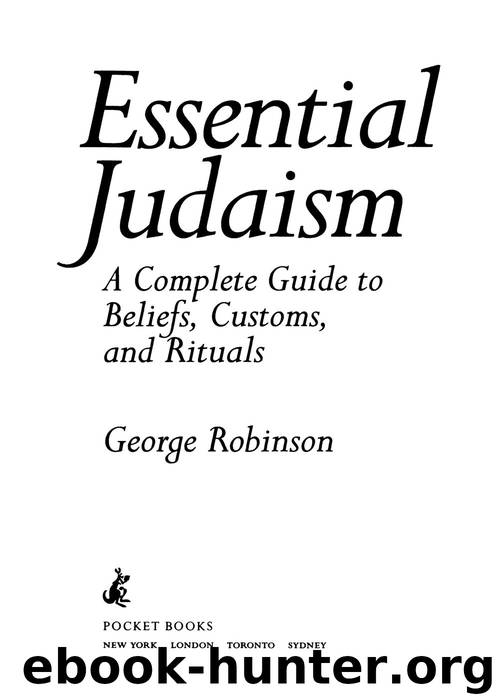Essential Judaism by George Robinson

Author:George Robinson
Language: eng
Format: mobi, epub
Publisher: Atria Books
Published: 2000-02-29T16:00:00+00:00
“O YOU SCRIBES AND PHARISEES!â€
Who were the men who wrote the Talmud? They were members of that political/religious formation reviled by Jesus and his followers, the Pharisees. We have already encountered one group of their detractors, the Saduccees, in Chapter 4. The rule-based Judaism that developed in the post-biblical period, in the writing of the Mishnah and Gemara, was the product, in part, of thought often associated with the Pharisees. To better understand Rabbinic Judaism, it is necessary to understand them.
In truth, there are many open questions about the Pharisees. Trust-worthy sources are hard to come by for this period. Much of what we know about them derives from highly colored accounts from Josephus, the Jewish-Roman historian who is our principal source on the “Jewish war†against Rome (including a vivid, if occasionally suspect, version of the death of the Jewish rebels at Masada); the Gospels of the New Testament; and the writings of the Church Fathers. Of course, none of these authors is objective: Josephus was a supporter of the Pharisees, perhaps a Pharisee himself; the authors of the Gospels and the Church Fathers were sworn enemies of the Pharisees.
This much seems clear. At some point during the period in which the Hasmonean dynasty ruled Palestine (approximately 164–63 B.C.E.), three distinct groups emerged within the Jewish community. The reason for the division was simple, as Dr. Albert I. Baumgarten, a contemporary Israeli scholar, explains.
If the period of the First Temple was one in which the central question of Jewish faith was whether to worship Adonai, the God of the Bible, alone, that question received a resounding answer with the Babylonian Exile: only Adonai was to be worshipped, and any pagan practices would be punished. “The Jews of the Second Temple period therefore were preoccupied with what can readily be understood as the next question in logical order,†Baumgarten writes. “Once a commitment to the God of the Bible alone and to [the] Torah is made, the crucial matter becomes what interpretation of the Torah shall prevail.†The lines within the Jewish community became sharply drawn around this issue as three groups emerged: the Saduccees, the Essenes, and the Pharisees.
These sects represented a small minority of the population of the Jewish world, probably no more than five percent in total, but their importance was far greater. As Baumgarten has written, they “set the tone for Jewish life as a whole,†setting themselves apart as ones who alternated between denouncing the corruption and impurities of an increasingly decadent Hasmonean kingdom and setting new moral standards for the monarchy. As Baumgarten notes, the sects found boundaries of behavior, setting themselves apart from the general Jewish population in areas as diverse as food, dress, commerce, marriage, and worship.
Sectarian practice . . . indicates the sense of disapproval of the manner in which fellow Jews observed the laws of the Torah, making separation from those Jews to a greater or lesser extent inevitable. I suggest that this sense of inadequate stringency is part of
Download
This site does not store any files on its server. We only index and link to content provided by other sites. Please contact the content providers to delete copyright contents if any and email us, we'll remove relevant links or contents immediately.
| Hebrew Bible (Old Testament) | Talmud |
| Torah | Zohar |
Man's Search for Meaning by Viktor E. Frankl(2254)
The Secret Power of Speaking God's Word by Joyce Meyer(2253)
Mckeown, Greg - Essentialism: The Disciplined Pursuit of Less by Mckeown Greg(2111)
MOSES THE EGYPTIAN by Jan Assmann(1970)
Unbound by Arlene Stein(1939)
Devil, The by Almond Philip C(1899)
The Complete Dead Sea Scrolls in English (7th Edition) (Penguin Classics) by Geza Vermes(1840)
I Capture the Castle by Dodie Smith(1571)
Schindler's Ark by Thomas Keneally(1513)
The Invisible Wall by Harry Bernstein(1458)
The Gnostic Gospel of St. Thomas by Tau Malachi(1412)
The Bible Doesn't Say That by Dr. Joel M. Hoffman(1372)
The Secret Doctrine of the Kabbalah by Leonora Leet(1266)
The Jewish State by Theodor Herzl(1251)
The Book of Separation by Tova Mirvis(1224)
A History of the Jews by Max I. Dimont(1206)
The Dead Sea Scrolls Bible by Martin G. Abegg(1199)
Political Theology by Carl Schmitt(1186)
Oy!: The Ultimate Book of Jewish Jokes by David Minkoff(1103)
